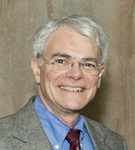From the Deputy Director for Intramural Research
Cognitive Resonance: How Do We Come Up with New Ideas?
I don’t pretend to be an expert in cognitive psychology, but I do spend a lot of time thinking about how scientists come up with innovative new hypotheses and new approaches to difficult scientific problems. And, of course, I want to be sure that we create an environment in the Intramural Research Program that optimizes the likelihood that creative lightning will strike our intramural scientists.

This commentary was stimulated by an article in my college alumni bulletin about how the Internet affects the way people think about problems. Some claim that acquiring and remembering information is no longer an essential element of learning, because so much is at our fingertips through search engines and the World Wide Web. We merely download the information onto our computers or our handheld gadgets. But what are the consequences of filling our brains with ways to obtain information rather than with the information itself?
One way to create new hypotheses is to let lots of information scurry around in the brain until there is an epiphany that organizes the knowledge around a central theme or explanation. How the brain works its magic is still unclear, but most of us have had the experience of pulling disparate information into a coherent hypothesis.
What happens, however, if the brain is devoid of the information that we need as a substrate for creative thinking? Eventually, our computers will be able to assemble data into new ideas for us (at which point, scientists may be obsolete), but that is not yet the case. Is it possible that fewer and fewer new hypotheses will result from this lack of empirical information in our heads?
The situation is complex. It can be argued that search engines allow us to amass far more information than ever before and therefore aid, rather than limit, the creative process. If so, we must make a conscious effort to remember some of the stream of facts and ideas coming from our computers so we can ponder that information and transform it into new ideas and hypotheses.
There are other important sources of cognitive input that inform scientists about the natural world. Our own observations and experiments are critically important, as are those of our colleagues. We learn about work in other domains from conversations, publications, and lectures. This brings me to the main practical point of this essay: To do the best science it is imperative to draw widely from many sources of information.
Here is what I recommend:
- Be alert to the most interesting science in your own and distant fields. This effort will ensure that you don’t try to solve a problem that has already been solved in a different system; learn the most effective techniques for solving problems in your field; and that you draw together information from multiple sources to generate new ideas.
- Take every opportunity to teach. Teaching helps you formulate the facts into concepts.
- Go to lectures and seminars at NIH and general sessions at the professional meetings that you attend. Some of the NIH lectures are videocast and archived, and many, such as the NIH Director’s Wednesday Afternoon Lecture Series (WALS), feature outstanding speakers and are designed to expose a general scientific audience to exciting new ideas and approaches. Here is just a sampling of lectures at NIH. Attend as many as you can:
- Read widely in the scientific literature. If you read only papers in your field you may be limited in your ability to make cognitive connections to generate new ideas. Read your favorite journals from cover to cover; look for articles that catch your attention. By reading broadly, you should assimilate as much information as possible to inform your own scientific work. All laboratories and scientific interest groups should have journal clubs to keep you informed and sharpen your critical thinking skills.
I would like to hear more about our scientific staff’s strategies to assimilate important information and your ideas for new approaches to achieve “cognitive resonance.”
This page was last updated on Monday, May 2, 2022
